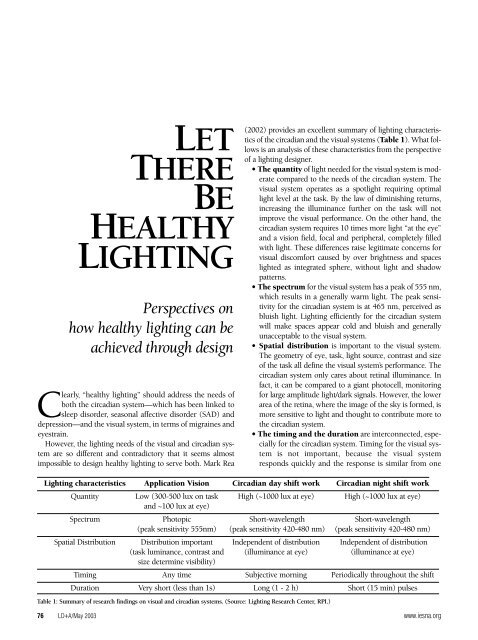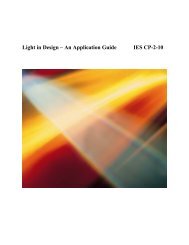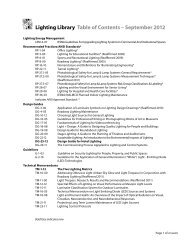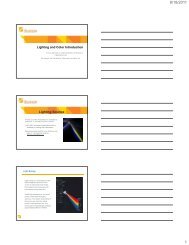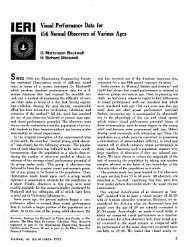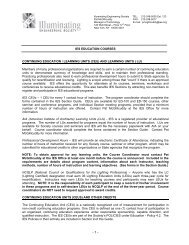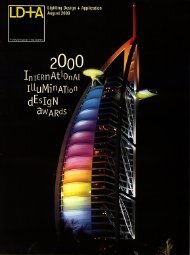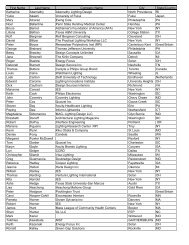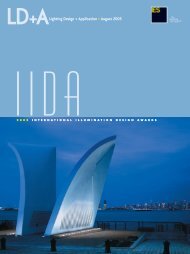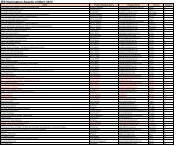an annual energy and maintenance savings of $.67 per sq. ft.in addition to a mess-free installation at less than five minutesper fixture.Cost To OwnLighting accounts for approximately 40 percent of total commercialelectric bills. When budgeting for lighting systems,what companies participating in reverse auctions often don’ttake into account is that purch<strong>as</strong>ing higher energy-efficientmodeled fixtures, rather than the lowest-priced fixtures, canoften repay the cost of each fixture in energy costs in a shorttimeframe. In addition, numerous utility providers offer rebatesin the range of $25 to $50 per fixture for customers to installenergy-efficient/energy saving technology. So while buyers mayonly see the higher upfront costs, the power savings may repaytheir investment very quickly.Once again, when looking at upfront costs, companies shoppingfor lighting fixtures through reverse auctions do not takeinto consideration the costs to maintain and service fixtures.For most traditional lighting sales, manufacturers’ sales representativescounsel buyers on the proper fixture not only to fittheir budget and their specific application needs, but also toensure that it is delivered on-time, packaged with all appropriateparts and with custom-designed instructions for properinstallation. Many manufacturers provide service within 72hours of delivery to respond to any problems or questions withthe product. With reverse auctions, buyers may sacrifice thishigh level of service before and after the sale in order to receivea low-priced fixture.In addition to quality service from the manufacturers, buyersmust realize that each lighting fixture can differ on its light levelsand lumen maintenance over time. If a lighting system doesnot provide a high-lumen maintenance, it will require endusersto supplement or replace fixtures sooner to maintain thesame light levels. This will result in additional fixture andmaintenance costs.Going back to the first example, Fixture 1 costs $.76 per sq.ft. to operate, while Fixture 2 only costs $.57 per sq. ft. (b<strong>as</strong>edon the <strong>as</strong>sumption of $.10/kWH). With this $.17 difference incombined purch<strong>as</strong>e and operational costs (see Figure 2), a500,000 sq. ft. facility would save $85,000 annually. In addition,since Fixture 2 required 25 percent fewer fixtures to providethe same illumination, the owner would save even moreon maintenance costs. The uninformed buyer in a reverse auctionwould end up paying an 850 percent premium on powerand maintenance to save $10,000 on upfront fixture costs.More Red FlagsRetail environments: For markets such <strong>as</strong> retail, where visualcomfort for shoppers is key to sales success, choosing the properlighting fixture is essential. Lighting characteristics, such <strong>as</strong>aesthetics, quantity of light and quality of light may be moreimportant than price when making purch<strong>as</strong>e decisions. Thesethree lighting characteristics determine the mood created whileshopping in the retail outlet, the visual comfort the store creates,<strong>as</strong> well <strong>as</strong> the ability to accurately display colors of theretail products. If purch<strong>as</strong>ing lower cost fixtures compromisesthe lighting of a retail store, then the shopping environmentFigure 1Cost to BuyCost to OwnCost per Fixture PowerCosts per FixtureCost to InstallCost to Maintain FixtureFigure 2Product specifications: 400W metal halide aluminumreflector high bay fixtureReflector Cost to purch<strong>as</strong>e Cost to own Net savingsFixture 1 16" round $.09/sq. ft. $.76/sq. ft. XFixture 2 22" elliptical $.11/sq. ft. $.57/sq. ft $.17/sq. ftFigure 3B<strong>as</strong>ed on 10-year amortization with energy costs at$.10/kWHPurch<strong>as</strong>e savings Annual energy savingsFixture 1 $10,000 XFixture 2 X $85,000will suffer, damaging the company’s image and sales in theprocess.Technology: Also lost in this f<strong>as</strong>t-paced virtual environment isthat buyers will never receive the opportunity to learn aboutthe many technological options that can ultimately enhancetheir business and/or save them money. If purch<strong>as</strong>e price is theultimate concern, innovative products will never receive theconsideration of buyers.Reverse auctions give end-users a false sense that they arecreating an opportunity to lower their costs, when they mayactually be hindering their business. They do not allow buyersto take into account the costs <strong>as</strong>sociated with lighting. In addition,while a system that provides an e<strong>as</strong>y and productiveforum for buyers of commodity products, reverse auctions cannotaccommodate the intense planning and service that is necessaryto purch<strong>as</strong>e sophisticated, high technology lighting systems.In the final analysis, lighting is a science and an art, and decisionsaffecting it are best left to the experts. When the bottomlinecost per fixture is a buyer’s only consideration, manufacturerstrying to win the bid can’t afford to provide proper serviceand technical advice. As a result, the reverse auctionprocess will only adversely affect facility operations.—Frank AustinThe author: Frank Austin is vice president of Thom<strong>as</strong>Lighting National Accounts, a division of the GenlyteThom<strong>as</strong> Group, a leading manufacturer of lighting fixturesand controls for commercial, industrial and residentialmarkets. Austin h<strong>as</strong> been active in the Thom<strong>as</strong>Lighting National Accounts since he started the group in1988. In addition, he h<strong>as</strong> held positions of vice president,marketing and sales Canada and vice president, strategicmarketing for Thom<strong>as</strong> Lighting. His company and its parent company havetaken a firm stance that they will not bid on reverse auctions.74 LD+A/May 2003 www.iesna.org
LETTHEREBEHEALTHYLIGHTINGPerspectives onhow healthy lighting can beachieved through designClearly, “healthy lighting” should address the needs ofboth the circadian system—which h<strong>as</strong> been linked tosleep disorder, se<strong>as</strong>onal affective disorder (SAD) anddepression—and the visual system, in terms of migraines andeyestrain.However, the lighting needs of the visual and circadian systemare so different and contradictory that it seems almostimpossible to design healthy lighting to serve both. Mark Rea(2002) provides an excellent summary of lighting characteristicsof the circadian and the visual systems (Table 1). What followsis an analysis of these characteristics from the perspectiveof a lighting designer.• The quantity of light needed for the visual system is moderatecompared to the needs of the circadian system. Thevisual system operates <strong>as</strong> a spotlight requiring optimallight level at the t<strong>as</strong>k. By the law of diminishing returns,incre<strong>as</strong>ing the illuminance further on the t<strong>as</strong>k will notimprove the visual performance. On the other hand, thecircadian system requires 10 times more light “at the eye”and a vision field, focal and peripheral, completely filledwith light. These differences raise legitimate concerns forvisual discomfort caused by over brightness and spaceslighted <strong>as</strong> integrated sphere, without light and shadowpatterns.• The spectrum for the visual system h<strong>as</strong> a peak of 555 nm,which results in a generally warm light. The peak sensitivityfor the circadian system is at 465 nm, perceived <strong>as</strong>bluish light. Lighting efficiently for the circadian systemwill make spaces appear cold and bluish and generallyunacceptable to the visual system.• Spatial distribution is important to the visual system.The geometry of eye, t<strong>as</strong>k, light source, contr<strong>as</strong>t and sizeof the t<strong>as</strong>k all define the visual system’s performance. Thecircadian system only cares about retinal illuminance. Infact, it can be compared to a giant photocell, monitoringfor large amplitude light/dark signals. However, the lowerarea of the retina, where the image of the sky is formed, ismore sensitive to light and thought to contribute more tothe circadian system.• The timing and the duration are interconnected, especiallyfor the circadian system. Timing for the visual systemis not important, because the visual systemresponds quickly and the response is similar from oneLighting characteristics Application Vision Circadian day shift work Circadian night shift workQuantity Low (300-500 lux on t<strong>as</strong>k High (~1000 lux at eye) High (~1000 lux at eye)and ~100 lux at eye)Spectrum Photopic Short-wavelength Short-wavelength(peak sensitivity 555nm) (peak sensitivity 420-480 nm) (peak sensitivity 420-480 nm)Spatial Distribution Distribution important Independent of distribution Independent of distribution(t<strong>as</strong>k luminance, contr<strong>as</strong>t and (illuminance at eye) (illuminance at eye)size determine visibility)Timing Any time Subjective morning Periodically throughout the shiftDuration Very short (less than 1s) Long (1 - 2 h) Short (15 min) pulsesTable 1: Summary of research findings on visual and circadian systems. (Source: Lighting Research Center, RPI.)76 LD+A/May 2003 www.iesna.org


